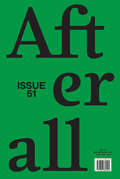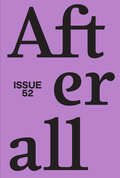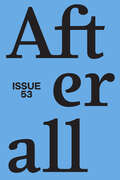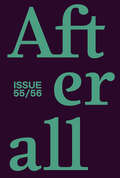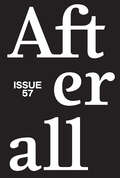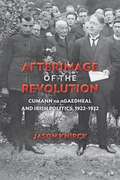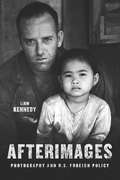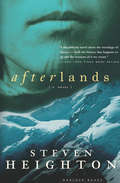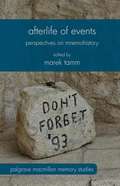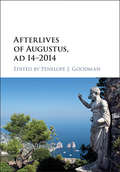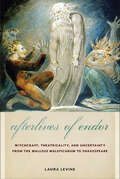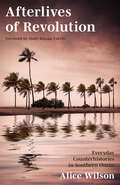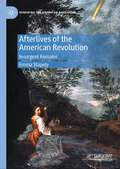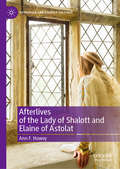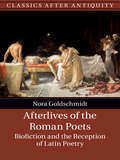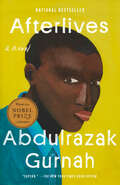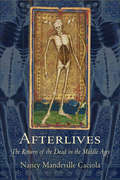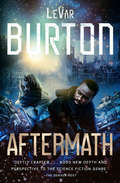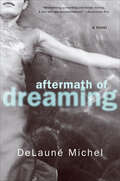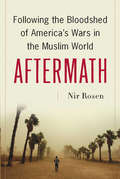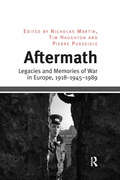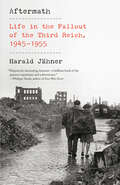- Table View
- List View
Afterall: A Journal of Art, Context and Enquiry, volume 51 number 1 (Spring 2021)
by Afterall: A Journal of Art, Context and EnquiryThis is volume 51 issue 1 of Afterall: A Journal of Art, Context and Enquiry. Afterall is a journal of contemporary art that provides in-depth analysis of art and its social, political, and philosophical contexts. Each issue provides the reader with well-researched contributions that discuss each artist's work from different perspectives. Contextual essays and other texts discussing events, works, or exhibitions further develop the thematic focus of each issue.
Afterall: A Journal of Art, Context and Enquiry, volume 52 number 1 (Autumn/Winter 2021)
by Afterall: A Journal of Art, Context and EnquiryThis is volume 52 issue 1 of Afterall: A Journal of Art, Context and Enquiry. Afterall is a journal of contemporary art that provides in-depth analysis of art and its social, political, and philosophical contexts. Each issue provides the reader with well-researched contributions that discuss each artist's work from different perspectives. Contextual essays and other texts discussing events, works, or exhibitions further develop the thematic focus of each issue.
Afterall: A Journal of Art, Context and Enquiry, volume 53 number 1 (Spring 2022)
by Afterall: A Journal of Art, Context and EnquiryThis is volume 53 issue 1 of Afterall: A Journal of Art, Context and Enquiry. Afterall is a journal of contemporary art that provides in-depth analysis of art and its social, political, and philosophical contexts. Each issue provides the reader with well-researched contributions that discuss each artist's work from different perspectives. Contextual essays and other texts discussing events, works, or exhibitions further develop the thematic focus of each issue.
Afterall: A Journal of Art, Context and Enquiry, volume 54 number 1 (Autumn/Winter 2022)
by Afterall: A Journal of Art, Context and EnquiryThis is volume 54 issue 1 of Afterall: A Journal of Art, Context and Enquiry. Afterall is a journal of contemporary art that provides in-depth analysis of art and its social, political, and philosophical contexts. Each issue provides the reader with well-researched contributions that discuss each artist's work from different perspectives. Contextual essays and other texts discussing events, works, or exhibitions further develop the thematic focus of each issue.
Afterall: A Journal of Art, Context and Enquiry, volume 55-56 number 1 (Spring 2023)
by Afterall: A Journal of Art, Context and EnquiryThis is volume 55-56 issue 1 of Afterall: A Journal of Art, Context and Enquiry. Afterall is a journal of contemporary art that provides in-depth analysis of art and its social, political, and philosophical contexts. Each issue provides the reader with well-researched contributions that discuss each artist's work from different perspectives. Contextual essays and other texts discussing events, works, or exhibitions further develop the thematic focus of each issue.
Afterall: A Journal of Art, Context and Enquiry, volume 57 number 1 (Spring 2024)
by Afterall: A Journal of Art, Context and EnquiryThis is volume 57 issue 1 of Afterall: A Journal of Art, Context and Enquiry. Afterall is a journal of contemporary art that provides in-depth analysis of art and its social, political, and philosophical contexts. Each issue provides the reader with well-researched contributions that discuss each artist's work from different perspectives. Contextual essays and other texts discussing events, works, or exhibitions further develop the thematic focus of each issue.
Afterimage
by Helen HumphreysIN THE TURBULENT WORLD OF VICTORIAN ENGLAND, A MAID, MISTRESS, AND MASTER ARE DRAWN INTO A FATEFUL LOVE TRIANGLE.
Afterimage
by Kevin J. Anderson Kristine Kathryn RuschThe strange people had restored her life after she had been raped and burned nearly to death. The only model they had to work with was her assailant.
Afterimage of the Revolution
by Jason KnirckAscending to power after the Anglo-Irish Treaty and a violent revolution against the United Kingdom, the political party Cumann na nGaedheal governed during the first ten years of the Irish Free State (1922-32). Taking over from the fallen Michael Collins and Arthur Griffith, Cumann na nGaedheal leaders such as W. T. Cosgrave and Kevin O'Higgins won a bloody civil war, created the institutions of the new Free State, and attempted to project abroad the independence of a new Ireland. In response to the view that Cumann na nGaedheal was actually a reactionary counterrevolutionary party, "Afterimage of the Revolution" contends that, in building the new Irish state, the government framed and promoted its policies in terms of ideas inherited from the revolution. In particular, Cumann na nGaedheal emphasized Irish sovereignty, the "Irishness" of the new state, and a strong sense of anticolonialism, all key components of the Sinn Fein party platform during the revolution. Jason Knirck argues that the 1920s must be understood as part of a continuing Irish revolution that led to an eventual independent republic. Drawing on state documents, newspapers, and private papers--including the recently released papers of Kevin O'Higgins--he offers a fresh view of Irish politics in the 1920s and integrates this period more closely with the Irish Revolution.
Afterimages
by Liam KennedyIn 2005, photographer Chris Hondros captured a striking image of a young Iraqi girl in the aftermath of the killing of her parents by American soldiers. The shot stunned the world and has since become iconic--comparable to the infamous photo by Nick Ut of a Vietnamese girl running from a napalm attack. Both images serve as microcosms for their respective conflicts. Afterimages looks at the work of war photographers like Hondros and Ut to understand how photojournalism interacts with the American worldview. Liam Kennedy here maps the evolving relations between the American way of war and photographic coverage of it. Organized in its first section around key US military actions over the last fifty years, the book then moves on to examine how photographers engaged with these conflicts on wider ethical and political grounds, and finally on to the genre of photojournalism itself. Illustrated throughout with examples of the photographs being considered, Afterimages argues that photographs are important means for critical reflection on war, violence, and human rights. It goes on to analyze the high ethical, sociopolitical, and legalistic value we place on the still image's ability to bear witness and stimulate action.
Afterlands: A Novel
by Steven Heighton&“A magnificent novel&” based on the 1872 Polaris expedition that left crewmembers marooned on an ice floe off the coast of Greenland (The New York Times Book Review). It is 1871. Nineteen men, women, and children, hailing from the United States, Germany, Denmark, England, and Sweden, and including two Inuit families, set out on Arctic explorer USS Polaris. But their voyage soon goes wrong. The ship founders, leaving its passengers adrift on an ice floe and, ultimately, stranded alone in the Arctic for six harrowing months. Based on an incredible true story, Afterlands envisions in vivid detail both the life-and-death challenges of the harsh landscape and the violent human threats of nationalism, ethnicity, rivalries, suspicion, hunger, and love. Weaving together fiction and history, and drawing on the writings of one of the passengers on the actual journey, Lt. George Tyson, Steven Heighton&’s &“beautifully written&” novel explores the shattering emotional and psychological consequences faced by those who survived (The Washington Post). &“An exceptionally satisfying adventure.&” —Publishers Weekly
Afterlife of Events
by Marek TammRecently, we have witnessed a rearticulation of the traditional relationship between the past, present and future, broadening historiography's range from studying past events to their later impact and meaning. The volume proposes to look at the perspectives of this approach called mnemohistory, and argues for a redefinition of the term 'event'.
Afterlives of Augustus, AD 14–2014
by Penelope J. GoodmanThe bi-millennium of Augustus' death on 19 August 2014 commemorated not only the end of his life but also the beginning of a two-thousand-year reception history. This volume addresses the range and breadth of that history. <P><P>Beginning with the Emperor's death and continuing through Late Antiquity, Early Christianity, the Middle Ages, the Renaissance and early modernity to the present day, chapters address political positioning, religious mythologisation, philosophy, rhetoric, narratives, memory, and material embodiment. As they collectively reveal, Augustus has meant radically different things from one time and place to another, and even to some individual commentators as the circumstances around them changed. The weight of established narratives has often also shaped those of subsequent generations, with or without their conscious awareness. The book outlines and analyses the major themes in Augustus' reception history, clarifying the cultural and historiographical issues at stake and providing a platform for further scholarship.<P> Gives a holistic view of Augustus' reception history from his death to the present day.<P> Demonstrates how much assessments of Augustus have always depended on the values and experiences of the viewer.<P> Uses the post-Classical receptions material at the heart of the book to cast valuable light back on the study of the historical Augustus.
Afterlives of Endor: Witchcraft, Theatricality, and Uncertainty from the "Malleus Maleficarum" to Shakespeare
by Laura LevineAfterlives of Endor offers an analysis of the way early modern English literature addressed the period's anxieties about witchcraft and theatricality. What determined whether or not a demonologist imagined a trial as a spectacle? What underlying epistemological constraints governed such choices and what conceptions of witchcraft did these choices reveal? Pairing readings of demonological texts with canonical plays and poetry, Laura Levine examines such questions. Through analyses of manuals and pamphlets about the prosecution of witches—including Reginald Scot's skeptical The Discoverie of Witchcraft (1584), King James VI/I's Daemonologie (1597), and Jean Bodin's De la Demonomanie des Sorciers (1580)—Afterlives of Endor examines the way literary texts such as Shakespeare's The Winter's Tale and The Tempest, Spenser's The Faerie Queene, and Marlowe's Tragicall History of Doctor Faustus address anxieties about witchcraft, illusion, and theatricality. Afterlives of Endor attends to the rhetorical tactics, argumentative investments, and underlying tensions of demonological texts with the scrutiny ordinarily reserved for literary texts.
Afterlives of Revolution: Everyday Counterhistories in Southern Oman
by Alice WilsonThe Dhufar Revolution was fought between 1965–1976, in an attempt to depose Oman's British-backed Sultan and advance social ideals of egalitarianism and gender equality. Dhufar, the southernmost governorate in today's Sultanate, captured global attention for its revolutionaries and their liberation movement's Marxist-inspired social change. But following counterinsurgency victory, Oman's government expunged the revolution from sanctioned historical narratives. Afterlives of Revolution offers a groundbreaking study of the legacies of officially silenced revolutionaries. How do their underlying convictions survive and inspire platforms for progressive politics in the wake of disappointment, defeat, and repression? Alice Wilson considers the "social afterlives" of revolutionary values and networks. Veteran militants have used kinship and daily socializing to reproduce networks of social egalitarianism and commemorate the revolution in unofficial ways. These afterlives revise conventional wartime and postwar histories. They highlight lasting engagement with revolutionary values, the agency of former militants in postwar modernization, and the limitations of government patronage for eliciting conformity. Recognizing that those typically depicted as coopted can still reproduce counterhegemonic values, this book considers a condition all too common across Southwest Asia and North Africa: the experience of defeated revolutionaries living under the authoritarian state they once contested.
Afterlives of the American Revolution: Insurgent Remains (Renewing the American Narrative)
by Emma StapelyThis book challenges the historical common sense that the American Revolution terminated in the birth of the United States. Prevailing narratives of the Revolutionary period rest on the assumption that the war ended with the Treaty of Paris in 1783. Yet from London to Philadelphia, and from the Six Nations’ trans-Appalachian homelands to the shores of Sierra Leone, the decades after the treaty’s signing roil with accounts that disturb the coherence of this chronological division. Insurgent Remains assembles a counter-archive of textual and visual materials—ranging from popular seduction tales and political cartoons to the writings of self-liberated African Americans—that furnishes alternative visions of revolutionary historical experience as an ongoing negotiation with violence and contingency. The book argues that the minor temporalities and political literacies registered in this archive cannot be accommodated by the progressive plot of nationalist history, in which the warfigures as a contest of only two sides (Tory/Whig, British/American, Loyalist/Patriot). Instead, they become legible as “remains”: traces of attachments, modes of collective association, and unresolved struggles that bear insurgent political potential in their own right.
Afterlives of the Lady of Shalott and Elaine of Astolat (Arthurian and Courtly Cultures)
by Ann F. HoweyThis book investigates adaptations of The Lady of Shalott and Elaine of Astolat in Victorian and post-Victorian popular culture to explore their engagement with medievalism, social constructions of gender, and representations of the role of art in society. Although the figure of Elaine first appeared in medieval texts, including Malory’s Le Morte Darthur, Tennyson’s poems about the Lady and Elaine drew unprecedented response from musicians, artists, and other authors, whose adaptations in some cases inspired further adaptations. With chapters on music, art, and literature (including parody, young people’s literature, and historical fiction and fantasy), this book seeks to trace the evolution of these characters and the ways in which they reinforce or challenge conventional gender roles, represent the present’s relationship to the past, and highlight the power of art.
Afterlives of the Roman Poets: Biofiction and the Reception of Latin Poetry (Classics after Antiquity)
by Nora GoldschmidtConscious of ancient modes of reading poetry 'for the life', Roman poets encoded versions of their lives into their texts. The result is a body of literature that cries out to be read in terms of lives in reception. Afterlives of the Roman Poets shows how the fictional biographies (or 'biofictions') of its authors have shaped the reception of Latin poetry. From medieval biographies of Ovid inscribed in the margins of his texts to republican readings of Lucan's death in periods of revolution to the 'death of the author' in Hermann Broch's Der Tod des Vergil, the book tells a cultural history of the reception of ancient literature as imagined through the lens of poets' lives. Putting modern life-writing studies and ancient poetry into dialogue, it brings biofictional reception to debates in classics, and puts antiquity and its reception onto the map of modern studies in life-writing.
Afterlives: A Novel
by Abdulrazak GurnahONE OF BARACK OBAMA'S FAVORITE BOOKS OF 2022 A NEW YORKER &“ESSENTIAL READ&”A NATIONAL BESTSELLERNAMED A BEST BOOK OF THE YEAR BY THE NEW YORK TIMES, THE WASHINGTON POST, TIME, THE NEW YORKER, BOOKPAGE, AND KIRKUS REVIEWS&“Superb. . . . A celebration of a place and time when people held onto their own ways, and basked in ordinary joys even as outside forces conspired to take them away.&” —New York TimesFrom the winner of the 2021 Nobel Prize in Literature, a sweeping, multi-generational saga of displacement, loss, and love, set against the brutal colonization of east Africa. When he was just a boy, Ilyas was stolen from his parents on the coast of east Africa by German colonial troops. After years away, fighting against his own people, he returns home to find his parents gone and his sister, Afiya, abandoned into de facto slavery. Hamza, too, returns home from the war, scarred in body and soul and with nothing but the clothes on his back–until he meets the beautiful, undaunted Afiya. As these young people live and work and fall in love, their fates knotted ever more tightly together, the shadow of a new war on another continent falls over them, threatening once again to carry them away.
Afterlives: The Return of the Dead in the Middle Ages
by Nancy Mandeville CaciolaSimultaneously real and unreal, the dead are people, yet they are not. The society of medieval Europe developed a rich set of imaginative traditions about death and the afterlife, using the dead as a point of entry for thinking about the self, regeneration, and loss. These macabre preoccupations are evident in the widespread popularity of stories about the returned dead, who interacted with the living both as disembodied spirits and as living corpses or revenants. In Afterlives, Nancy Mandeville Caciola explores this extraordinary phenomenon of the living's relationship with the dead in Europe during the five hundred years after the year 1000.Caciola considers both Christian and pagan beliefs, showing how certain traditions survived and evolved over time, and how attitudes both diverged and overlapped through different contexts and social strata. As she shows, the intersection of Christian eschatology with various pagan afterlife imaginings—from the classical paganisms of the Mediterranean to the Germanic, Celtic, Slavic, and Scandinavian paganisms indigenous to northern Europe—brought new cultural values about the dead into the Christian fold as Christianity spread across Europe. Indeed, the Church proved surprisingly open to these influences, absorbing new images of death and afterlife in unpredictable fashion. Over time, however, the persistence of regional cultures and beliefs would be counterbalanced by the effects of an increasingly centralized Church hierarchy. Through it all, one thing remained constant: the deep desire in medieval people to bring together the living and the dead into a single community enduring across the generations.
Aftermath
by LeVar BurtonThe acclaimed actor&’s shockingly prescient novel of speculative fiction &“presents a near-future United States torn apart by civil war and deep racial strife&” (Tampa Bay Times). America today is teetering on the edge of the alarming vision presented in LeVar Burton&’s debut novel, written more than two decades ago . . . In 2012, the first African American president is assassinated by a white extremist—just four days after he is elected. The horrific tragedy leads to riots, financial collapse, and ultimately, a full-on civil war. In its aftermath, millions are left homeless as famine and disease spread throughout the country. But from Chicago, a mysterious voice cries out . . . To Leon Crane, a former NASA scientist now struggling to survive on the streets, the pleas he hears remind him of the wife he could not save—and offer him a chance at redemption. To Jacob Fire Cloud, a revered Lakota medicine man, the voice is a sign that the White Buffalo Woman has returned to unite all the races in peace and prosperity. And to little Amy Ladue, the cries are those of her mother, who disappeared during the devastating St. Louis earthquake—and who must still be alive. These three strangers will be drawn together to rescue someone they have never met, a woman who holds the key to a new future for humanity—one remarkably brimming with hope. &“LeVar Burton brings a strong new voice to science fiction with this powerful, even disturbing, novel.&” —Ben Bova, New York Times–bestselling author &“An amazingly good first novel.&” —Rocky Mountain News &“I highly recommend this book!&” —Whoopi Goldberg
Aftermath of Dreaming: A Novel
by DeLaune MichelHypnotic and beautifully written, Aftermath of Dreaming is an incandescent first novel of odern life and love.Other than the little problem that she is waking up screaming in the middle of the night, life is wonderful for Yvette Broussard. Her jewelry-design career is taking off, she's back with her sort-of boyfriend, and, best of all, she no longer thinks about her once-in-a-lifetime love, international movie star Andrew Madden. Until a chance encounter with him changes everything.Swept up by memories of their complex relationship, Yvette is plunged into an obsession with Andrew that ultimately forces her to confront the past she thought she had left behind. At the same time, she is juggling the demands of her bride-to-be sister and her male best friend, who is jealous of other men, and thoughts of her estranged father.Set against the glittering worlds of Los Angeles and New York, and told with both humor and pathos, Aftermath of Dreaming explores the universal themes of abandonment, forgiveness, and letting go.
Aftermath: Following the Bloodshed of America's Wars in the Muslim World
by Nir RosenAs Iraq confronts a bleak and uncertain future and instability spreads throughout the region, an award winning journalist describes the new shape of the Middle East
Aftermath: Legacies and Memories of War in Europe, 1918–1945–1989
by Tim HaughtonFocusing on three of the defining moments of the twentieth century - the end of the two World Wars and the collapse of the Iron Curtain - this volume presents a rich collection of authoritative essays, covering a wide range of thematic, regional, temporal and methodological perspectives. By re-examining the traumatic legacies of the century’s three major conflicts, the volume illuminates a number of recurrent yet differentiated ideas concerning memorialisation, mythologisation, mobilisation, commemoration and confrontation, reconstruction and representation in the aftermath of conflict. The post-conflict relationship between the living and the dead, the contestation of memories and legacies of war in cultural and political discourses, and the significance of generations are key threads binding the collection together. While not claiming to be the definitive study of so vast a subject, the collection nevertheless presents a series of enlightening historical and cultural perspectives from leading scholars in the field, and it pushes back the boundaries of the burgeoning field of the study of legacies and memories of war. Bringing together historians, literary scholars, political scientists and cultural studies experts to discuss the legacies and memories of war in Europe (1918-1945-1989), the collection makes an important contribution to the ongoing interdisciplinary conversation regarding the interwoven legacies of twentieth-century Europe’s three major conflicts.
Aftermath: Life in the Fallout of the Third Reich, 1945-1955
by Harald JähnerHow does a nation recover from fascism and turn toward a free society once more? This internationally acclaimed revelatory history—"filled with first-person accounts from articles and diaries" (The New York Times)—of the transformational decade that followed World War II illustrates how Germany raised itself out of the ashes of defeat and reckoned with the corruption of its soul and the horrors of the Holocaust. Featuring over 40 eye-opening black-and-white photographs and posters from the period. The years 1945 to 1955 were a raw, wild decade that found many Germans politically, economically, and morally bankrupt. Victorious Allied forces occupied the four zones that make up present-day Germany. More than half the population was displaced; 10 million newly released forced laborers and several million prisoners of war returned to an uncertain existence. Cities lay in ruins—no mail, no trains, no traffic—with bodies yet to be found beneath the towering rubble. Aftermath received wide acclaim and spent forty-eight weeks on the best-seller list in Germany when it was published there in 2019. It is the first history of Germany's national mentality in the immediate postwar years. Using major global political developments as a backdrop, Harald Jähner weaves a series of life stories into a nuanced panorama of a nation undergoing monumental change. Poised between two eras, this decade is portrayed by Jähner as a period that proved decisive for Germany's future—and one starkly different from how most of us imagine it today.
